Updated 2/24/15: Corrected pricing
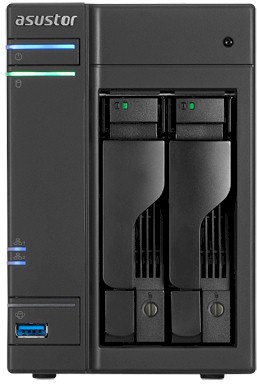
| At a glance | |
|---|---|
| Product | ASUSTOR NAS Server (AS5102T) [Website] |
| Summary | Two-bay quad core Intel Core J1900 Celeron NAS with lots of ports and wide range of downloadable apps. |
| Pros | • High performance @ reasonable price • USB 2.0, 3.0 and eSATA ports • RAM upgradable to 8 GB |
| Cons | • Nothing significant |
Typical Price: $372 Buy From Amazon

| At a glance | |
|---|---|
| Product | ASUSTOR NAS Server (AS5104T) [Website] |
| Summary | Four-bay quad core Intel J1900 Core Celeron NAS with lots of ports and wide range of downloadable apps. |
| Pros | • High performance @ reasonable price • USB 2.0, 3.0 and eSATA ports • RAM upgradable to 8 GB |
| Cons | • Nothing significant |
Typical Price: $477 Buy From Amazon
Introduction
Earlier this month I reviewed ASUSTOR’s AS500XT NAS family intended for the “Home to Power User”. This review will focus on ASUSTOR’s next step up, the AS510XT line targeted at “Power User to Business” customers. Like the AS500XT (where “X”= the number of drive bays), the AS51XXT line includes 2, 4, 8 and 10 bay products. As in our previous review, this review focuses on the two and four-bay versions
Here are the differences between the two series of products:
Processor – The AS51XXT all use an Intel J1900 2.0 GHz quad-core Celeron processor (burst up to 2.41 GHz); The AS50XXT series uses an Intel J1800 2.4 GHz dual-core Celeron processor (burst up to 2.58 GHz).
Memory – The AS510XT ships with 2 GB of DDR3 RAM. The AS500XT ship with 1 GB. Product in both families of NASes are upgradeable to 8 GB total RAM.
LCD Panels – None of the AS50XXT models have LCD status panels. The four, eight and 10 bay AS51XXT’s do.
Disk Trays – The disk trays on the AS51XXT NASes have locks. The disk trays on the AS50XXT NASes don’t.
All of the other features of the AS51XXT family of NASes are identical to those of the AS50XXT family. Since the only other differences are in performance, we’ll jump directly to the performance section of the review.
Performance
ADM 2.3.1.R1K7 firmware was loaded onto the AS5104T review sample and performance tests were run using the Revision 5 NAS test process. Since the AS5102T uses the same processor, RAM and Ethernet components, all testing was done on the AS5104T. The AS5104T tests used four drives configured in single RAID 0, 5 and 10 volumes. The AS5102T tests used two drives in single RAID 0 and 1 volumes. All tests were run using Western Digital Red 3 TB (WD30EFRX) drives provided by WD.
Normally, the first chart I look at when evaluating NAS performance is the default NAS chart that looks at File Copy Write Performance. I filter for the number of drives and the latest test method (black bars) and see where the NAS being currently reviewed appears. The composite image below shows how the AS5102T (left) and the AS 5104T (right) compare to other products matching the filters.
The test for both ASUSTOR AS510XT NASes turned in virtually identical scores of ~ 110 MB/s, ranked near the top of the charts and were virtually identical to their AS500XT siblings. File Copy Read performance was similar, at 107.5 MB/s (AS5102T) and 108.1 MB/s (AS5104T) and both ranked near the top of the charts for their filtered products. Both of the AS510XT products were about 1 MB/s faster than their corresponding AS500XT siblings – less than 1% difference.
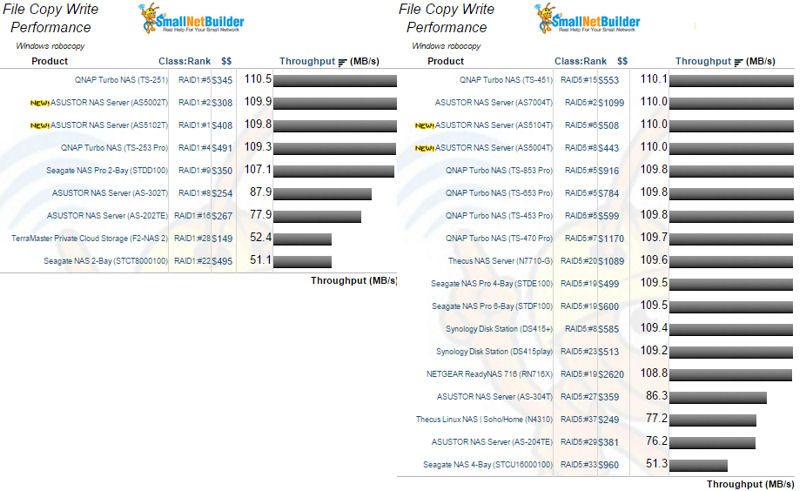
File Copy Write Performance, RAID 1 and 5 products
Next, I look at the Benchmark Summary, which shows all test results for each product. In the composite image below, you’ll note that for both the AS5102T (left) an the AS5104T (right), the results are remarkably consistent. There was really very little difference in the File Copy Write and File Copy Read numbers for any tested RAID level for either set of tests run. eSATA and USB 3.0 backups tests, as well as iSCSI read/write tests were all in excess of 100 MB/s.
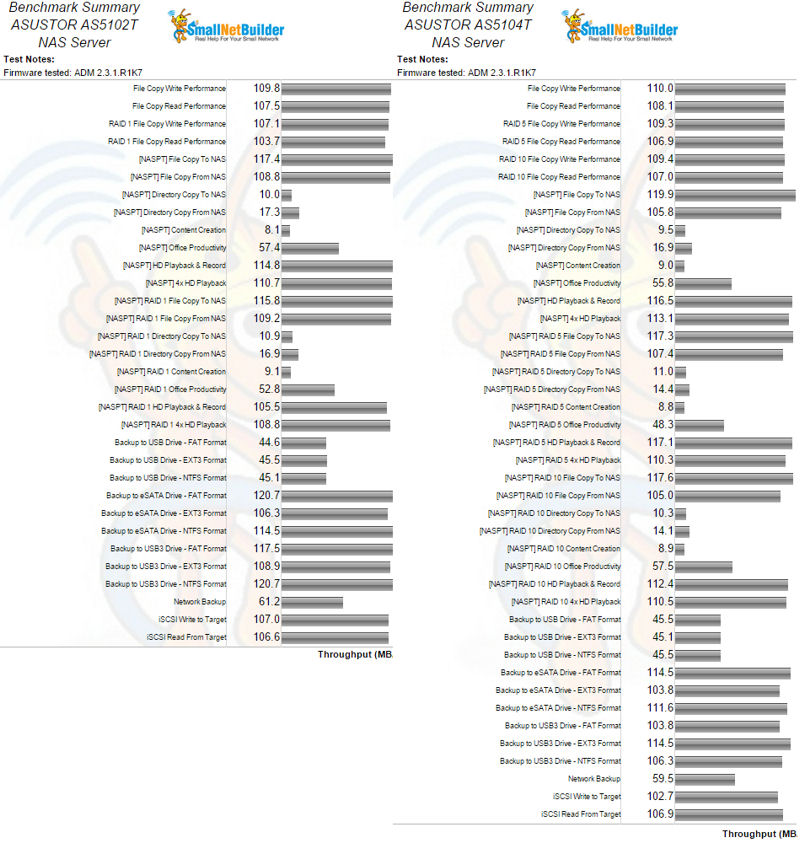
Benchmark Summaries
Performance – more
In the new version of the NAS Ranker, you can filter products by testing method version (Revision 4 or 5) and Class (No RAID, RAID 1 or RAID 5). You can still sort by rank or by price (in ascending or descending order). This replaces the old version that filtered by number of drives and class of processor. While the class of processor is important, what you really want to know is how NASes perform compared to each other within RAID classes.
RAID 1
First, let’s look at the RAID 1 class, which will include the AS5102T as well as other 2-bay NASes. I left the default Revision 5 Test Method (the current method) and generated a chart for Total NAS ranking. In the composite image below, this ranking is shown on the left and shows that the AS5102T has taken over as the top-ranked RAID 1 NAS from its AS5002T sibling, now ranked #2.
Being at the top of the charts means that there are no other NASes that match the filter with better performance at a lower price. To see how it stacks up to the competition, I also sorted by ascending price. Those results are shown on the right. There are quite a few 2-bay NASes that are cheaper than the $408 AS5104T, including the second cheapest, the #6 ranked ASUSTOR AS-202TE, the third cheapest, the #4 ranked ASUSTOR AS-302T, and the fourth cheapest, the #2 ranked ASUSTOR AS5002T.
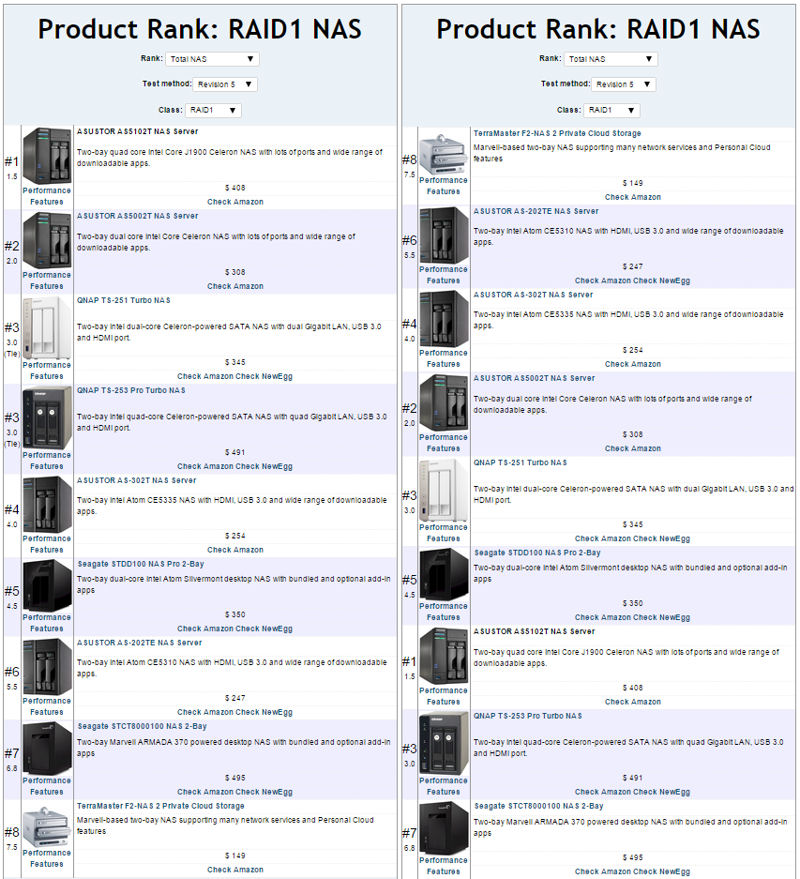
Total RAID 1 NAS Rank for by rank (left) and ascending price(right)
For comparison, I decided to include performance summaries for the #2 ranked ASUSTOR AS5002T, which is $100 less expensive than its top- ranked sibling, and the #3 ranked QNAP TS-253 Pro NAS. Though the QNAP TS-251 Pro was tied with the TS-253 and is quite a bit cheaper, I included the TS-253 Pro since, like the AS5102T, it has a quad-core Celeron processor.
The category results for the AS5102T and the AS5002T were very close and in the case of Read benchmarks, were tied with a #1 ranking. While the TS-253 Pro, like AS5004T had two category wins, its Total NAS ranking was pulled down by lower scores in Mixed Read Write, Backup and iSCSI.
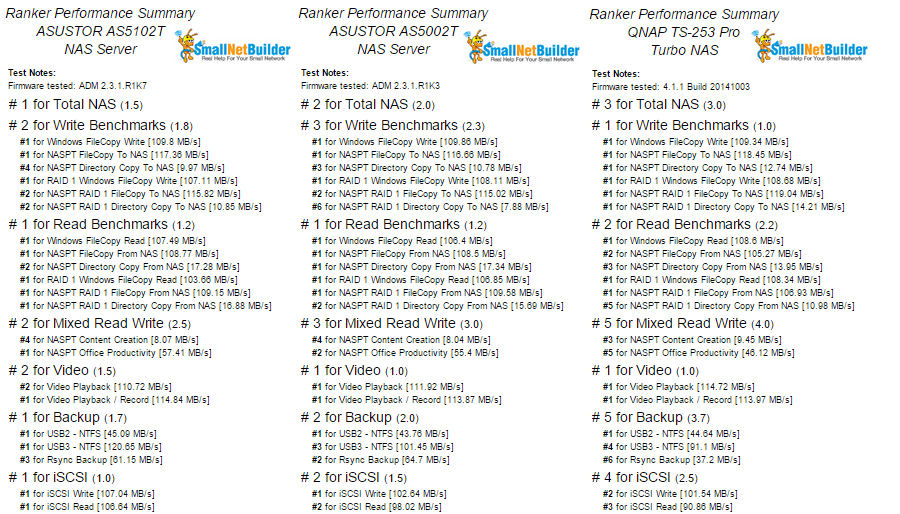
Ranker Performance Summary comparison
RAID 5
Updated 2/24/15
Note: The pricing we used for the AS5104T was high. Correct current pricing on Amazon is $508, which puts it between the AS5004T and QNAP TS-453 Pro.
As with the RAID 1 rankings above, I used the NAS Ranker to filter for RAID 5 class products, which include the ASUSTOR AS5104T. In the composite image below, Total NAS ranking is shown on the left and the results, sorted by ascending price, are displayed on the right.
The results were somewhat different than the RAID 1 results above. The AS5104T grabbed the #2 ranking and trailed only the ASUSTOR AS7004 i3-based NAS that costs $433 almost twice as much. The ASUSTOR AS504T trailed at #5. Looking at the chart on the right, sorted by ascending price, the fifth-ranked ASUSTOR AS5004T looks like a good value as the fourth least expensive 4-bay NAS.
With a total of 18 RAID 5 products tested with the current Revision 5 method, there’s significantly more competition than for 2-bay NASes. In addition to the AS5004T, ASUSTOR has two other products cheaper than the AS5104T, but both have Total NAS rankings that are poorer. The #13 ranked ASUSTOR AS-204TE is the second cheapest NAS and the #12 ranked ASUSTOR AS-304T is the third cheapest.
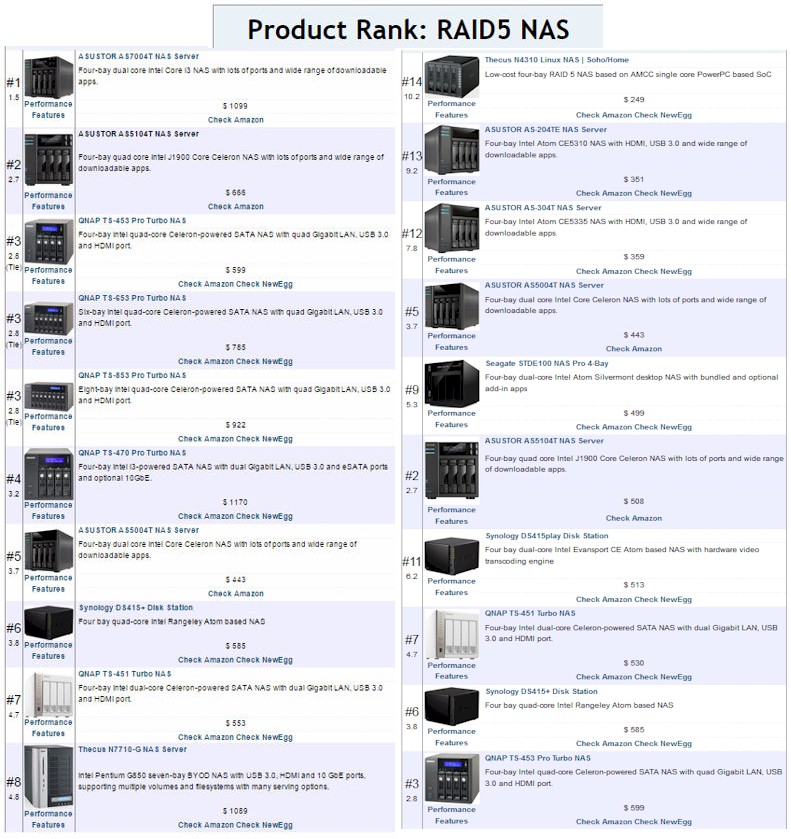
Total RAID 5 NAS Rank for by rank (left) and ascending price(right)
For RAID 5 performance comparison, I decided to include the #3 ranked QNAP TS-453 Pro NAS, which is $67 cheaper almost $100 more expensive than the AS5104T as well as the #5 ranked ASUSTOR AS5004T, which is $223 around $60 cheaper than the AS5104T. I was especially interested in the comparison between the two ASUSTOR products since the major hardware differences are the processors and the amount of memory.
Looking at the subcategories, the results were pretty much as expected. The AS5104T outperformed the AS5004T in every category but only by a small amount except for READ benchmarks, where the two tied. However, the QNAP TS-453 had better category rankings for Write, Read, and Mixed Read Write Benchmarks. The QNAP’s Total NAS score was pulled down by lower category scores for Backup and iSCSI. In short, the AS5104 squeaked out its #2 Total NAS rank by 0.1 point. (2.7 vs. 2.8 for the QNAP TS-453)
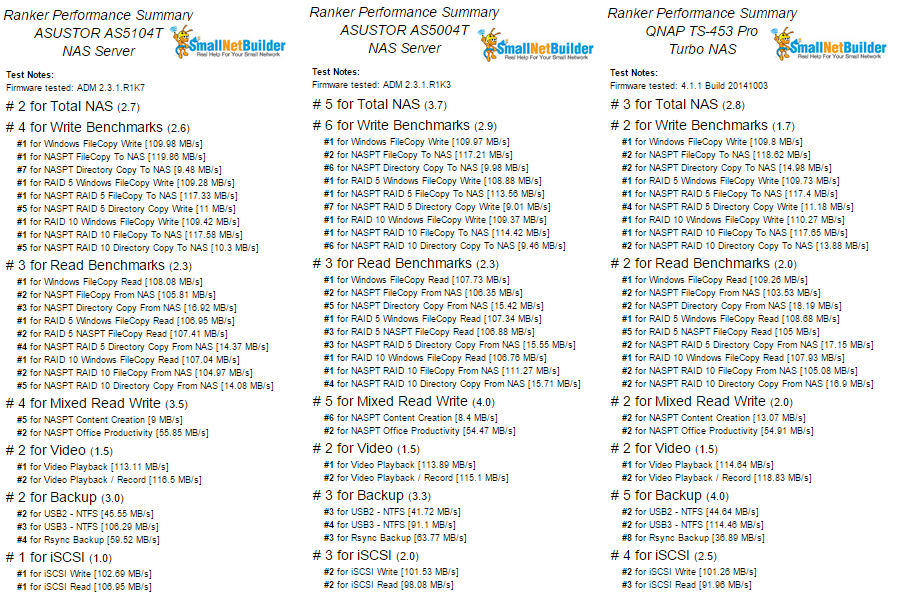
Ranker Performance Summary comparison of the ASUSTOR AS5104T (l), the ASUSTOR AS5004T (c) and the QNAP TS-453 Pro Turbo NAS (r)
Closing Thoughts
Updated 2/24/15
As I concluded in the previous review of the ASUSTOR 500XT products, the “5-series” NASes offer a significant improvement compared to ASUSTOR’s 2-series and 3-series of NASes. However, the AS51XXT’s offer only incremental performance improvement at higher prices compared to the AS50XXT family.
In evaluating the performance results, keep in mind that our test suite uses only a single client connected via one Gigabit Ethernet port. With so many products with similar values at the top of the charts, it’s clear we’re running into limitations of our test method for these higher end NASes that don’t have 10GbE ports. You are more likely to reap full value of the incremental investment in an AS51XXT NAS when using multiple clients and dual aggregated Gigabit Ethernet ports.
That said, for 2-bay NASes, the ASUSTOR AS5102T and AS5002T hold the #1 and #2 (respectively) spots on the charts for Total NAS ranking. It’s going to cost $100 more to buy the top-ranked NAS compared to its #2 sibling. If you prefer QNAP, the TS-251 Pro costs $37 more than the AS5002T and the TS-253 Pro costs $183 more. Since neither the AS5002T nor AS5102T have an LCD panel, the sweet spot for 2-bay NASes is the AS5002T.
The pricing spread between the AS5104T and the AS5004T is even a bit larger ~ $60. There are differences in processor and memory (which is upgradeable in both NASes) and the AS5104T features an LCD panel. But it’s difficult to justify that much of a price difference based on the incremental performance differences we saw with our single-client test suite.
The QNAP TS-453 Pro, priced $67 cheaper around $100 more than the AS5104T, turned in excellent performance numbers and only faltered slightly in categories (backup and iSCSI) that might not be important to some buyers. In both the Read and Write benchmarks, the QNAP TS-453 Pro slightly outperformed both of the ASUSTOR 5-series NASes and was within 0.1 points—not a significant difference—of tying the AS5104T for Total NAS ranking
ASUSTOR has once again shown it can produce NASes with chart-topping performance at more affordable prices than its competition. For 2-bay NASes, the AS5002T, though slightly lower ranked, offers the best bang for the buck. For 4-bay NASes, the QNAP TS-453 Pro hits the sweet spot for price/performance followed closely by the AS5004T. For four-bay NASes the AS5004T hits the sweet spot for price / performance.
